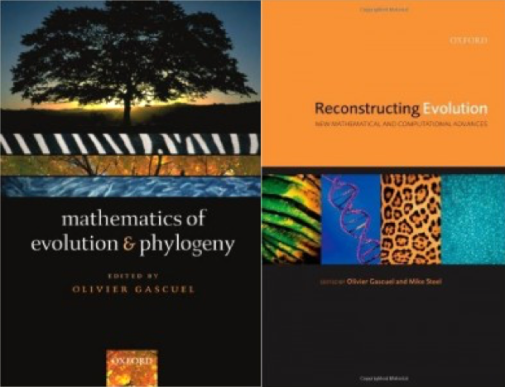
Olivier GASCUEL



Phylogenetics
My main research interest is in the field of evolution and phylogeny. My focus is on the mathematical and computational tools and concepts, which form an essential basis of evolutionary studies (2005 book, 2007 book). I am working on algorithms for phylogenetic inference. I (co)authored several software programs, some widely diffused and well cited: BioNJ (Mol Biol Evol 1997), FastME (J Comp Biol 2002, Mol Biol Evol 2004, Mol Biol Evol 2015) , SDM (Syst Biol 2006), PhyD* (BMC Bioinformatics 2008), Phylogeny.fr and NG-Phylogeny.fr (NAR 2008, NAR 2019), SeaView (Mol Biol EVol 2010), and PhyML (Syst Biol 2003, Syst Biol 2010, Bioinformatics 2019, Highly Cited!). Beyond tree building, testing is essential. I coauthored fast tests for branch support (Syst Biol 2006, Syst Biol 2011). Recently, we revisited the famous phylogenetic bootstrap of Felsenstein (>40,000 citations) and proposed a new version, the transfer bootstrap expectation (TBE, Nature 2018, web site), resulting in higher branch supports. Applications to large data sets and trees show that TBE reveals their phylogenetic signals, whereas Felsenstein’s bootstrap fails to do so. To build trees, estimate evolutionary distances and study sequence evolution, we need models. I coauthored probabilistic models to describe protein evolution (Phil Trans Roy Soc B 2008, Mol Biol Evol 2008, Syst Biol 2010, Mol Biol Evol 2012), and a new estimation method for amino acid replacement matrices, which was used to infer the the LG matrix (Mol Biol Evol 2008, Bioinformatics 2011). We also: designed a fast and simple web interface to select phylogenetic models in the PhyML environment (SMS, MBE 2017, web site); published a very fast dating method, implemented in the LSD software (Syst Biol 2015); proposed a fast maximum-likelihood method to infer and visualize ancestral scenarios, implemented in PastML (Mol Biol Evol 2019). With Mike Steel and Fabio Pardi, we addressed several theoretical questions related to tree building from evolutionary distances (Mol Biol Evol 2006, Bull Math Biol 2010, PNAS 2012, Algorithmica 2015), and to reconstruct ancestral characters (Math Biosciences 2010, Syst Biol 2014, Syst Biol 2020).
Pathogens
During the last twelve years, I turned part of my activities toward pathogens, most notably Plasmodium falciparum, HIV and, recently, SARS-CoV-2. Regarding P. falciparum our main goal was to decipher the function of its genes, most of them being fully unknown. We used postgenomic data and machine learning approaches to propose functional predictions for a number of its genes (BMC Bioinformatics 2008, BMC Genomics 2010). We refined the annotation of its proteins in structural domains (Bioinformatics 2009, BMC Bioinformatics 2012) and designed the RED2 method and program to search for regulation motifs (Genome Biology 2012). We also studied the origin of P. falciparum (BMC Evol Biol 2011). Regarding HIV and other viruses, notably Influenza, we implemented the PhyloType web server to extract relevant clusters or “phylotypes” from a phylogeny combined with extrinsic characters. PhyloType was applied to the phylogeography of HIV epidemics (Bioinformatics 2013). PastML is a continuation of PhyloType. We studied the emergence and diffusion of drug resistance mutations in HIV, both in the UK (AIDS 2015) and Africa (AIDS 2016). Importantly, our evolutionary analyses of large data sets support the idea that asp is the 10th gene of HIV-1 group M and indicate a correlation with the spread of the pandemic (PNAS 2016). Regarding SARS-CoV-2, we studied its origin, diffusion and global spread (PNAS 2020, CR Biol 2020), and designed an HMM-based web server to align the genomes of its variants at a very large scale (Bioinformatics 2020).
Current and recent services
Distinctions
